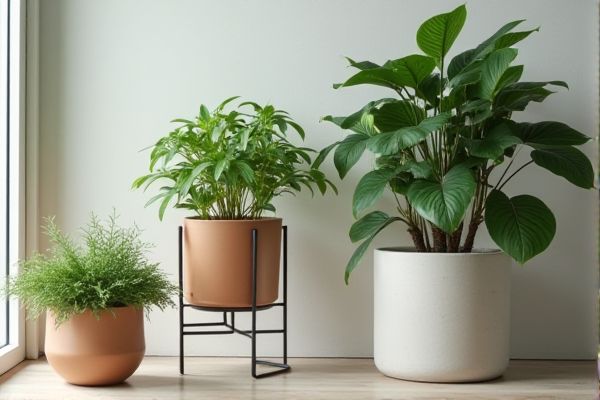
Metal planters offer durability and a modern aesthetic, retaining heat well but potentially causing root stress in hot climates, while ceramic planters provide excellent insulation and breathability but are more fragile and heavier. Discover which planter best suits Your gardening needs by reading the rest of the article.
Table of Comparison
| Feature | Metal Planter | Ceramic Planter |
|---|---|---|
| Durability | Highly durable, resistant to impact and weather | Fragile, prone to cracking and chipping |
| Weight | Lightweight, easy to move | Heavy, less portable |
| Temperature Regulation | Heats up quickly, can affect roots | Maintains stable temperature, protects roots |
| Drainage | Often requires additional drainage holes | Usually comes with built-in drainage |
| Aesthetic | Modern and industrial look | Classic and decorative appearance |
| Maintenance | May rust, needs occasional treatment | Low maintenance, easy to clean |
| Cost | Generally affordable | Can be expensive depending on design |
Introduction to Metal and Ceramic Planters
Metal planters offer durability, modern aesthetics, and excellent heat retention, making them ideal for outdoor and industrial-style gardens. Ceramic planters provide superior moisture retention, intricate designs, and a natural look that enhances indoor and traditional garden settings. Choosing between metal and ceramic planters depends on your plant's watering needs and your preferred decorative style.
Material Composition and Durability
Metal planters offer superior durability due to their corrosion-resistant alloys like galvanized steel or aluminum, making them ideal for outdoor use and harsh weather conditions. Ceramic planters, crafted from clay and fired at high temperatures, provide excellent moisture retention but are more prone to cracking or chipping under impact or extreme temperature changes. Choosing a metal planter ensures long-lasting structural integrity, while ceramic planters emphasize aesthetic appeal with moderate durability for indoor or sheltered environments.
Aesthetic Appeal and Design Options
Metal planters offer a sleek, modern aesthetic with a variety of finishes, including matte, glossy, and textured options, making them ideal for contemporary or industrial design themes. Ceramic planters provide rich color depth and intricate patterns, lending a timeless and artisanal feel that complements traditional and rustic decor styles. Your choice between metal and ceramic planters can significantly influence the visual impact and cohesion of your indoor or outdoor garden space.
Weight and Portability Considerations
Metal planters are generally lighter than ceramic planters, making them easier to move and reposition in gardens or indoor spaces. Ceramic planters tend to be heavier and more fragile, which can limit portability and increase the risk of breakage during transport. For gardening enthusiasts seeking lightweight and durable options, metal planters offer superior portability without compromising on style.
Drainage and Root Health
Metal planters often lack built-in drainage holes which can lead to water accumulation and root rot if not carefully managed, whereas ceramic planters typically have drainage holes that promote proper water flow and prevent soggy soil conditions. The heat conductivity of metal can cause soil temperatures to fluctuate more drastically, potentially stressing plant roots, while ceramic planters provide better insulation, maintaining stable moisture levels ideal for root health. Choosing a ceramic planter with adequate drainage is generally more beneficial for sustaining healthy root systems and preventing overwatering issues.
Temperature Regulation for Plants
Metal planters conduct heat rapidly, causing soil temperatures to fluctuate more drastically and potentially stressing plant roots in extreme weather. Ceramic planters offer better insulation, maintaining more stable soil temperatures that protect plant roots from overheating in summer and freezing in winter. Choosing ceramic planters improves temperature regulation, enhancing plant growth and health.
Maintenance and Cleaning Requirements
Metal planters require regular cleaning to prevent rust and corrosion, especially in humid or wet environments, and often need protective coatings or sealants for longevity. Ceramic planters are easier to maintain, as they are generally resistant to weathering and can be cleaned with mild soap and water, but they are more prone to cracking or chipping upon impact. Both materials benefit from periodic inspection to ensure drainage holes remain clear, reducing the risk of root rot and promoting healthy plant growth.
Cost Comparison
Metal planters typically cost less upfront than ceramic planters, offering durability and a modern aesthetic at an affordable price point. Ceramic planters tend to be more expensive due to their handcrafted nature, decorative finishes, and heavier materials. Your choice depends on budget flexibility and the desired balance between cost efficiency and visual appeal.
Environmental Impact and Sustainability
Metal planters, typically made from recyclable materials like aluminum or steel, offer longevity and can be repurposed, reducing landfill waste and energy consumption over time. Ceramic planters, although biodegradable and natural, often require high-temperature kilns for production, leading to greater carbon emissions and less energy efficiency compared to metal alternatives. Choosing metal planters supports sustainable practices through durability and recyclability, whereas ceramic planters align with biodegradability but incur higher environmental costs during manufacturing.
Choosing the Right Planter for Your Needs
Metal planters offer durability and sleek modern aesthetics, making them ideal for both indoor and outdoor use, especially in harsh weather conditions. Ceramic planters provide excellent moisture retention and breathability, which supports healthy root growth and enhances plants' overall well-being. When choosing the right planter for your needs, consider factors like climate exposure, plant type, and maintenance preferences to ensure optimal growth and longevity.
 homyna.com
homyna.com